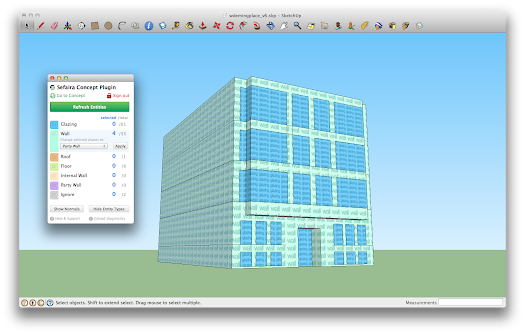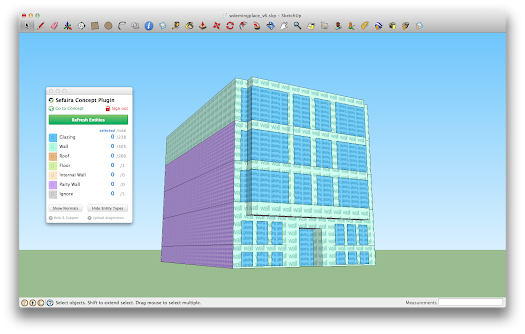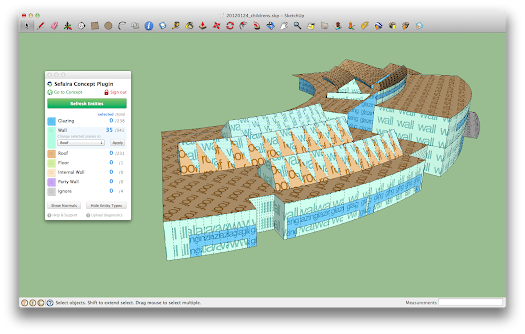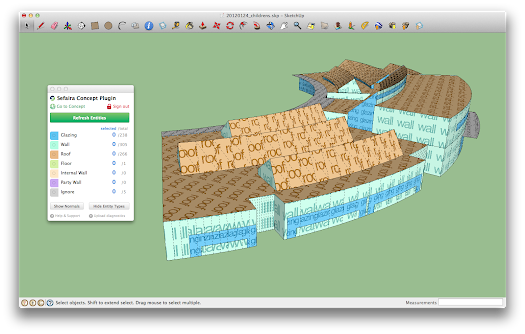SketchUp Pro Case Study: Green building design with Sefaira and SketchUp Pro
November 27th, 2012 | Published in Google SketchUp
This post comes to us from our friends at Sefaira. In this blog, we’ll see how Booth Hansen, a nationally recognized Architecture, Planning, and Interior Design firm, uses Sefaira Concept and the Concept plugin for SketchUp Pro to incorporate green building analyses into the earliest stages of design.
Sefaira Concept + SketchUp Pro for Green Building Design
Traditionally, thermal simulation packages or energy models assess compliance at the end of the design process. Using Sefaira Concept, Booth Hansen can rapidly analyze and evaluate “what-if” scenarios at the earliest stages of design. These scenarios provide clients with the relative energy savings of various design strategies. Using the Concept plugin for SketchUp Pro, Booth Hansen ensures the accurate representation of their models during these early stage sustainability analyses. Simply, it's important that Sefaira Concept knows that a door is a door, and a window is a window; it turns out that SketchUp Pro's dynamic components are pretty good at this. Let’s look at two project examples.
Deming Place
The first step in performing early stage sustainability analysis with Sefaira Concept is to import building geometry from a SketchUp file. Sefaira Concept automatically identifies the physical elements of a model – including floors, walls, glazing, and roofs – so that the software can deliver real-time, iterative analyses that may inform design choices.
Deming Place is located mid-block in an urban context and shares party walls with neighbors on either side. Sefaira Concept initially identified the party walls as standard walls. However, modeling these as standard walls would incorrectly simulate thermal transfer to outside air.
 |
| Sefaira Concept classifies the geometry within a SketchUp model for energy analysis: here, the distinction is only made between walls and glazings. |
The Concept plugin for SketchUp allows designers to visualize Sefaira Concept’s interpretation of the model within SketchUp, make adjustments to this interpretation, or provide additional information as necessary. In this case, Booth Hansen designers chose to override the initial designations: the side walls of Deming Place were selected and changed to party walls, which more closely represented the actual building conditions.
 |
| Here, the Concept Plugin for SketchUp is used to reclassify walls that are shared with neighboring structures; now Sefaira Concept knows to treat these differently in scenario forecasting |
Sefaira Concept then used the party walls to define the enclosed space earmarked for analysis. Ultimately, Booth Hansen determined there was no significant thermal transfer through these walls, under the assumption that the interior of buildings on either side are kept at roughly the same internal temperature as Deming Place.
Children’s Center at the Chicago Botanic Gardens
For the Children’s Center at the Chicago Botanic Gardens, Booth Hansen utilized a series of concentric circles to define the building’s floor plan. This design resulted in a geometrically complex roof structure at the clerestory windows.
 |
| The base SketchUp model for the Children's Center at the Chicago Botanic Gardens |
To make sure that the energy analysis was accurate, Booth Hansen’s architects needed to know that Sefaira Concept had correctly identified and categorized the building’s different elements.
 |
| Sefaira Concept's initial analysis of the model: the clerestory roofs have been classified as a hybrid of wall and roof planes |
Using the Concept Plugin, Booth Hansen could see that Sefaira Concept had identified the clerestory roofs as a combination of wall and roof planes. Booth Hansen corrected this initial interpretation using the Concept plugin, so that all clerestory roofs would be correctly analyzed as “roof.”
 |
| Using the Concept plugin for SketchUp, the roof geometry is correctly reclassified; the model is now ready for analysis. |
Once uploaded into Sefaira Concept for analysis, Booth Hansen was able to parametrically manipulate the properties of the roof surfaces (such as R-value and construction type).
Results
In these projects, Booth Hansen was able to use limited information available in conceptual design (such as basic massings, floor plan layouts, and site location) to measure sustainability impact across their design choices. Particularly with Deming Place, Sefaira Concept and the Concept Plugin for SketchUp helped establish a best practice model for sustainable design of similar buildings.
Posted by Sam Somashekar, Sefaira
Interested to demo Sefaira Concept and the Concept plugin? Check in with Sefaira.